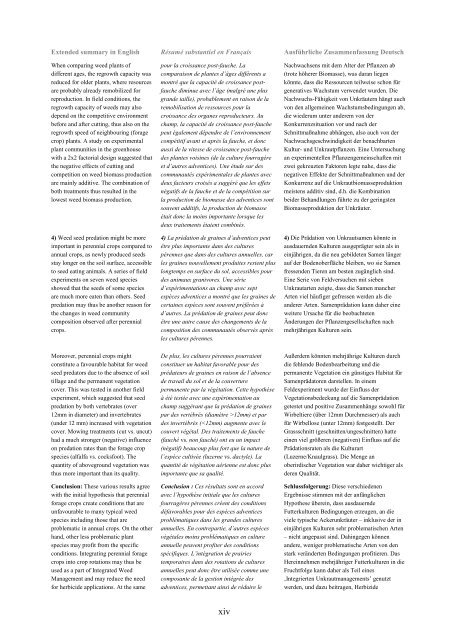Diversifying crop rotations with temporary grasslands - Université de ...
Diversifying crop rotations with temporary grasslands - Université de ...
Diversifying crop rotations with temporary grasslands - Université de ...
Create successful ePaper yourself
Turn your PDF publications into a flip-book with our unique Google optimized e-Paper software.
Exten<strong>de</strong>d summary in English Résumé substantiel en Français Ausführliche Zusammenfassung Deutsch<br />
When comparing weed plants of<br />
different ages, the regrowth capacity was<br />
reduced for ol<strong>de</strong>r plants, where resources<br />
are probably already remobilized for<br />
reproduction. In field conditions, the<br />
regrowth capacity of weeds may also<br />
<strong>de</strong>pend on the competitive environment<br />
before and after cutting, thus also on the<br />
regrowth speed of neighbouring (forage<br />
<strong>crop</strong>) plants. A study on experimental<br />
plant communities in the greenhouse<br />
<strong>with</strong> a 2x2 factorial <strong>de</strong>sign suggested that<br />
the negative effects of cutting and<br />
competition on weed biomass production<br />
are mainly additive. The combination of<br />
both treatments thus resulted in the<br />
lowest weed biomass production.<br />
4) Weed seed predation might be more<br />
important in perennial <strong>crop</strong>s compared to<br />
annual <strong>crop</strong>s, as newly produced seeds<br />
stay longer on the soil surface, accessible<br />
to seed eating animals. A series of field<br />
experiments on seven weed species<br />
showed that the seeds of some species<br />
are much more eaten than others. Seed<br />
predation may thus be another reason for<br />
the changes in weed community<br />
composition observed after perennial<br />
<strong>crop</strong>s.<br />
Moreover, perennial <strong>crop</strong>s might<br />
constitute a favourable habitat for weed<br />
seed predators due to the absence of soil<br />
tillage and the permanent vegetation<br />
cover. This was tested in another field<br />
experiment, which suggested that seed<br />
predation by both vertebrates (over<br />
12mm in diameter) and invertebrates<br />
(un<strong>de</strong>r 12 mm) increased <strong>with</strong> vegetation<br />
cover. Mowing treatments (cut vs. uncut)<br />
had a much stronger (negative) influence<br />
on predation rates than the forage <strong>crop</strong><br />
species (alfalfa vs. cocksfoot). The<br />
quantity of aboveground vegetation was<br />
thus more important than its quality.<br />
Conclusion: These various results agree<br />
<strong>with</strong> the initial hypothesis that perennial<br />
forage <strong>crop</strong>s create conditions that are<br />
unfavourable to many typical weed<br />
species including those that are<br />
problematic in annual <strong>crop</strong>s. On the other<br />
hand, other less problematic plant<br />
species may profit from the specific<br />
conditions. Integrating perennial forage<br />
<strong>crop</strong>s into <strong>crop</strong> <strong>rotations</strong> may thus be<br />
used as a part of Integrated Weed<br />
Management and may reduce the need<br />
for herbici<strong>de</strong> applications. At the same<br />
pour la croissance post-fauche. La<br />
comparaison <strong>de</strong> plantes d’âges différents a<br />
montré que la capacité <strong>de</strong> croissance postfauche<br />
diminue avec l’âge (malgré une plus<br />
gran<strong>de</strong> taille), probablement en raison <strong>de</strong> la<br />
remobilisation <strong>de</strong> ressources pour la<br />
croissance <strong>de</strong>s organes reproducteurs. Au<br />
champ, la capacité <strong>de</strong> croissance post-fauche<br />
peut également dépendre <strong>de</strong> l’environnement<br />
compétitif avant et après la fauche, et donc<br />
aussi <strong>de</strong> la vitesse <strong>de</strong> croissance post-fauche<br />
<strong>de</strong>s plantes voisines (<strong>de</strong> la culture fourragère<br />
et d’autres adventices). Une étu<strong>de</strong> sur <strong>de</strong>s<br />
communautés expérimentales <strong>de</strong> plantes avec<br />
<strong>de</strong>ux facteurs croisés a suggéré que les effets<br />
négatifs <strong>de</strong> la fauche et <strong>de</strong> la compétition sur<br />
la production <strong>de</strong> biomasse <strong>de</strong>s adventices sont<br />
souvent additifs, la production <strong>de</strong> biomasse<br />
était donc la moins importante lorsque les<br />
<strong>de</strong>ux traitements étaient combinés.<br />
4) La prédation <strong>de</strong> graines d’adventices peut<br />
être plus importante dans <strong>de</strong>s cultures<br />
pérennes que dans <strong>de</strong>s cultures annuelles, car<br />
les graines nouvellement produites restent plus<br />
longtemps en surface du sol, accessibles pour<br />
<strong>de</strong>s animaux granivores. Une série<br />
d’expérimentations au champ avec sept<br />
espèces adventices a montré que les graines <strong>de</strong><br />
certaines espèces sont souvent préférées à<br />
d’autres. La prédation <strong>de</strong> graines peut donc<br />
être une autre cause <strong>de</strong>s changements <strong>de</strong> la<br />
composition <strong>de</strong>s communautés observés après<br />
les cultures pérennes.<br />
De plus, les cultures pérennes pourraient<br />
constituer un habitat favorable pour <strong>de</strong>s<br />
prédateurs <strong>de</strong> graines en raison <strong>de</strong> l’absence<br />
<strong>de</strong> travail du sol et <strong>de</strong> la couverture<br />
permanente par la végétation. Cette hypothèse<br />
à été testée avec une expérimentation au<br />
champ suggérant que la prédation <strong>de</strong> graines<br />
par <strong>de</strong>s vertébrés (diamètre >12mm) et par<br />
<strong>de</strong>s invertébrés (

















